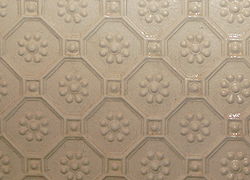

Lincrusta is a deeply embossed wallcovering, invented by Frederick Walton. Walton was already known for patenting linoleum floor covering in 1860. [1] [2] Lincrusta was launched in 1877 and was used in a host of applications from royal homes to railway carriages. Many examples over a hundred years old can still be found throughout the world.
Contents
Commonly found in Victorian properties and restoration projects, [2] Lincrusta is also frequently used in commercial projects such as hotel foyers, bars, restaurants and casinos. Notable installations included six staterooms on the Titanic , and in the United States the White House, the Winchester Mystery House [3] and Roseland Cottage in Woodstock, Connecticut, where it has been completely restored and is on view to the public. [4]